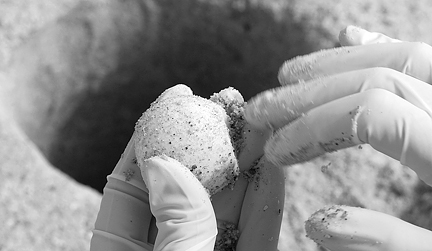DNA analysis from freshly laid loggerhead sea turtle eggs suggests long-held belief about nesting habits of the protected species might not be completely accurate.
Research scientists from the University of Georgia’s Warnell School of Forestry and Natural Resources began analyzing data in 2008. Originally confined to turtles nesting on the Georgia coastline, the project extended to South Carolina and North Carolina in 2010.
The Wrightsville Beach Sea Turtle Project sent its first loggerhead egg sample in 2011, adding 14 samples to more than 33,000 collected to date. While the study is ongoing and no formal conclusions have been drawn from the data yet, Wrightsville Beach Sea Turtle Project coordinator Nancy Fahey said the data already suggests new ways of understanding turtle behavior.
“They are mysterious. This is a nonintrusive way of learning so much more about them,” Fahey said. “It gives us an opportunity to read so much more into their behavior.”
Past methods of learning about the turtles, like allowing volunteers to intercept nesting activity to tag a turtle’s flipper, provided a few shaky theories about where and how often females nest.
Loggerheads nest on average three or four times every two to three years. The turtles have been believed to exhibit loyalty to the beaches where they hatched, returning to that beach or one nearby to deposit their eggs. Between periods of nesting, turtles remain a few miles from the shore. Every two weeks, they swim to shore and crawl onto the sand to deposit a clutch of more than 100 eggs.
One of the biggest discoveries gleaned from the data so far challenges how loyal nesting mothers are to native beaches.
“We’re learning the true story of nest-site fidelity, and that tells us that not all turtles have a strong inclination to return to the same beach,” Fahey said.
Data collected on Wrightsville Beach suggests turtles remain within 60 kilometers, or 37 miles, to lay nests, compared to a statewide average of 69 kilometers and a project-wide average of 26 kilometers.
The study has found that turtles in North Carolina, South Carolina and Georgia lay on average 4.71 nests per season, one every eight or nine days. On Wrightsville Beach, the numbers are a little lower at 1.73 nests per female every eight or nine days.
Nesting activity on Wrightsville Beach has declined since 2000, dipping to only one nest some years. Many factors could deter the turtles, Fahey said, including unusual sandbar formation, beach erosion and human disturbance. She hopes the data ultimately provides a clue suggesting why some beaches see a fluctuation in nesting activity — like in Wrightsville Beach, which hosted eight nests during the 2013 season compared to one in 2014.
Fahey wonders if the overall drop in Wrightsville’s nesting activity was in part due to nest relocation to Figure Eight Island and Masonboro Island during the late ‘80s and early ’90s, an activity discouraged by the guidelines that now govern statewide sea turtle projects.
“Over the years, the guidelines have evolved to better preserve the natural behavior of the turtles,” Fahey said. “Moving from one island to another? It could definitely cause some kind of confusion. Who’s to say, but it makes you wonder if that is a reason behind the decline we’ve seen between 2000 and 2010.”
She hopes turtles hatched since 1994, when the Wrightsville Beach Sea Turtle Project originated, beginning to reach maturity now, will lead to an increase in nesting activity.
Loggerheads are protected as a threatened species. Hatchlings face a naturally low chance of survival due to threats from terrestrial and marine predators.
To participate, Fahey had to extract one egg from each freshly laid clutch found on Wrightsville Beach to submit for testing, which initially made her uncomfortable, but she admits she sees the benefit now.
“I don’t really like sacrificing an egg, and at first I resisted it. … But what we’re learning is so valuable that perhaps sacrificing that one egg is bringing us great return,” Fahey said.
email [email protected]




